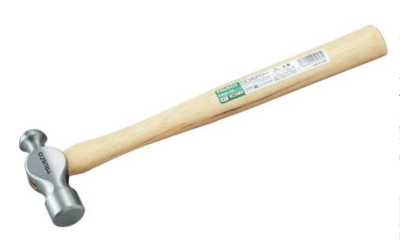What Is a One-Handed Hammer
 A hammer is a general term for a tool used to strike an object, consisting of a metal striking portion (head) and a hand-holding portion (handle).
A hammer is a general term for a tool used to strike an object, consisting of a metal striking portion (head) and a hand-holding portion (handle).
A one-handed hammer is a type of hammer that is primarily used for metalworking work. It is sometimes also called a pound hammer or ball-point hammer.
The striking portion of a one-handed hammer has a gently curved surface (flat head) that is nearly flat on one side and a spherical shape (round head) on the opposite side. The flat-headed side is used for hammering in nails and pins, while the round-headed side is used for bending metal. The round head is particularly suitable for striking heated materials or workpieces.
How to Use One-Handed Hammers
When using one-handed hammers for pin hammering, use the flat head side and strike the pin so that the center of the striking surface is straight at the pin.
The flat head has a gently curved surface, so if you strike straight at the center of the flat head, you will not leave a strike mark on the material. However, if the periphery of the flat head hits the pin instead of the center, the shaft may be off-axis, resulting in damage to the material and possible injury to the operator.
The round-head side is used for metal bending, rivet tip crimping, engraving, and grinding out marks that have been missed. When using the round head of the hammer, ensure you strike straight down the center in the same manner as the flat head.
How to Select One-Handed Hammers
One-handed hammers come in various sizes, depending on the weight of the head. The basic nominal number 1 one-handed hammer weighs 1 pound (about 450 g), and based on this size, there are sizes such as 1/4 lb (100 g), 1/2 lb (250 g), 3/4 lb (350 g), 1.5 lb (650 g), and 2 lb (900 g). Select the size according to the work to be performed and the material to be processed.
When working with one-handed hammers, using a smaller size hammer and applying excessive force may result in the hammer missing its target or slipping out of the hand. For safety reasons, it is advisable to choose one-handed hammers of a slightly larger size that can be struck without hitting too hard.
One-handed hammers come in various handles, including wooden, fiberglass, and steel. Wooden hammers have the disadvantage of being prone to breakage. However, they come with the advantage of user-replaceable handles and are lightweight, making them easy to swing. Fiberglass is heavier and more challenging to swing, but its composition with glass fibers makes it less prone to breakage. Even if it does break, the head is less likely to detach. Steel is the most difficult material to break.
Since there is a trade-off between weight and resistance to breakage, it is advisable to select one according to the highest priority conditions, taking into consideration the nature of the work, the work environment, and the workers.